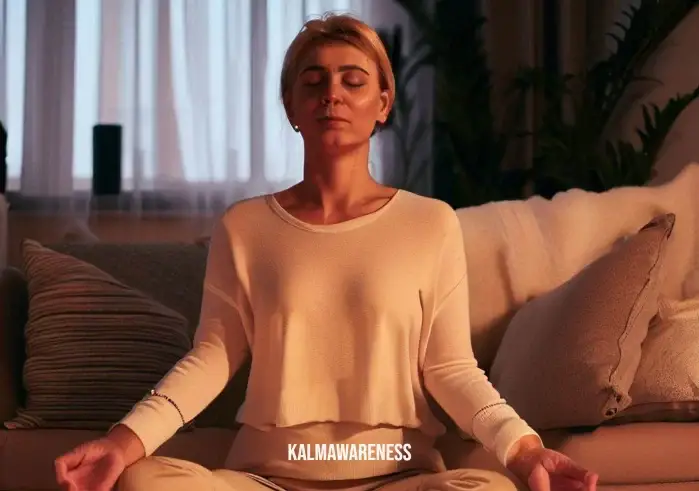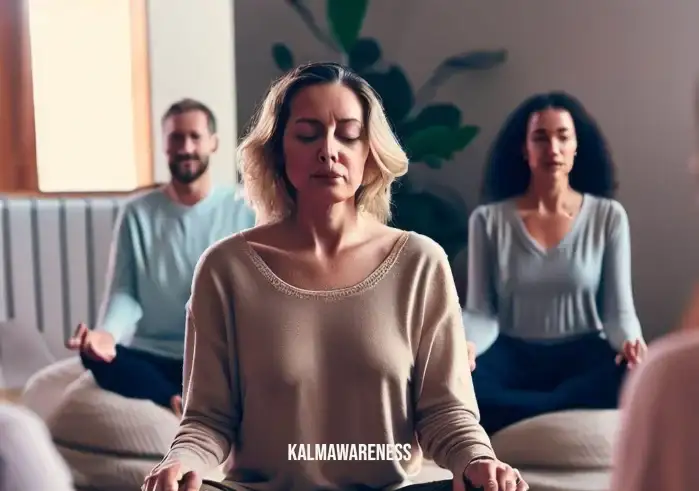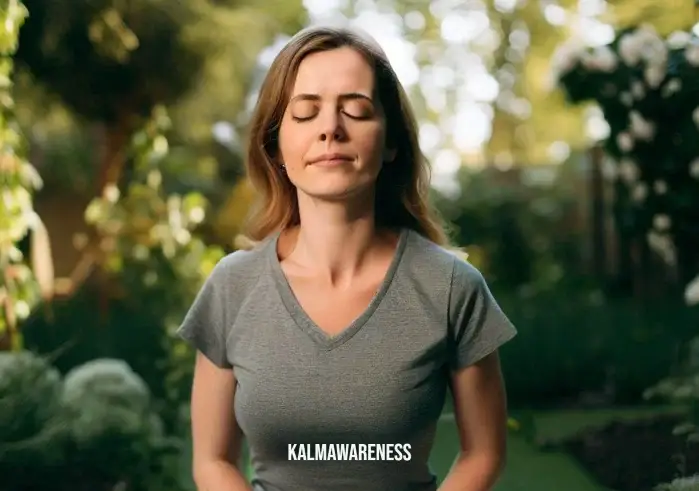Guided Meditation for Pelvic Floor Relaxation: Your Path to Comfort and Healing
In the complex journey of life, we often encounter challenges that test our physical strength, emotional resilience, and mental agility. Among these challenges, physical discomfort and pain can significantly impact our wellbeing and daily functioning. Especially when this discomfort stems from the pelvic floor, it can interrupt our most basic bodily functions, causing stress, anxiety, and an overall decline in quality of life. But there is a solution: guided meditation for pelvic floor relaxation.
This practice, rooted in mind-body healing, offers a gentle and non-invasive approach to alleviate pelvic floor tension and pain. More than that, it provides a path to greater self-awareness, helping us cultivate a deeper understanding of our bodies, our pain, and our innate capacity for healing.
“Awareness is the greatest agent for change.” – Eckhart Tolle
Understanding the Pelvic Floor
Our pelvic floor is a complex network of muscles that extends from the tailbone to the pubic bone, playing an essential role in our bodily functions like urination, bowel movements, and sexual health. However, various factors such as childbirth, surgery, age, or stress can cause these muscles to become tense or weak. This, in turn, can result in discomfort or even chronic pain.
Just like any other muscle in the body, the pelvic floor can benefit from regular relaxation and strengthening exercises. However, what sets the pelvic floor apart is its connection with our emotional state. Stress, anxiety, and trauma can manifest physically, often leading to tension in the pelvic region. Therefore, addressing this tension requires not only physical relaxation but also emotional release.
Embracing Mind-Body Healing
When it comes to easing tension and promoting relaxation in the pelvic floor, mind-body healing is paramount. It acknowledges the inextricable link between our physical health and emotional wellbeing, promoting healing practices that address both aspects.
One such practice is guided meditation for pelvic floor relaxation, an approach that combines visualization, conscious breathing, and mindfulness techniques. It encourages the release of physical tension and emotional stress, aiding in pain relief and overall pelvic health.
The Role of Guided Meditation
Guided meditation is a potent tool in the journey towards pelvic floor relaxation and healing. It uses a structured narrative or visualization, directed by a guide or teacher, to lead the practitioner through a meditative journey. The aim is to foster a state of deep relaxation and inner peace, aiding in physical healing and emotional release.
When applied to pelvic floor relaxation, guided meditation offers a safe and accessible way to explore bodily sensations, release tension, and cultivate a sense of wellbeing. It becomes a channel to communicate with our bodies, understand the roots of our discomfort, and learn how to alleviate it through mindful practices.
An integral aspect of guided meditation for pelvic floor relaxation is conscious breathing. As we anchor our attention to the breath, we create a bridge between our body and mind, promoting relaxation and easing tension in the pelvic floor muscles. Additionally, conscious breathing serves as a natural pain management tool, providing a calming effect that soothes discomfort and fosters healing.
Remember, healing is a journey. It requires patience, understanding, and compassion towards oneself. Guided meditation for pelvic floor relaxation is not an overnight solution but a pathway towards improved health, enhanced self-awareness, and overall wellbeing.
In the next section, we’ll delve deeper into the practice of guided meditation, discussing its core principles and how they relate to pelvic floor relaxation. I invite you to continue reading to learn more about this potent healing tool and how it can transform your relationship with your body.

Embracing Guided Meditation for Pelvic Floor Relaxation: Techniques and Benefits
As we continue our exploration of guided meditation for pelvic floor relaxation, it’s important to understand the specific techniques that make this practice effective. Remember, meditation isn’t just about calming the mind; it’s about fostering a deep connection with our bodies, understanding our discomfort, and unlocking our healing potential. With the right techniques, you can navigate the path to pelvic floor relaxation and pain relief.
Key Techniques in Guided Meditation for Pelvic Floor Relaxation
Guided meditation employs a variety of techniques designed to promote relaxation, ease tension, and cultivate mindfulness. These techniques, when applied to the pelvic floor, can significantly alleviate discomfort and enhance overall health.
- Mindful Awareness: Central to any meditation practice is the cultivation of mindful awareness. Mindfulness involves directing our attention to the present moment, allowing us to tune into our bodies and recognize areas of tension or discomfort. In guided meditation for pelvic floor relaxation, this awareness becomes a crucial tool in identifying and releasing tension in the pelvic muscles.
- Breathing Techniques: Conscious breathing serves as an anchor in guided meditation, helping us connect with our bodies and promote relaxation. Specifically, deep diaphragmatic breathing can stimulate relaxation responses in the body, alleviating tension in the pelvic floor muscles.
- Visualization: Visualization is a powerful technique used in guided meditation. It involves imagining a calming scene or a healing light that can help you relax and focus on your pelvic area. This can greatly help in releasing the tension from the pelvic muscles and bring about a feeling of relaxation.
Benefits of Guided Meditation for Pelvic Floor Relaxation
The practice of guided meditation, particularly when geared towards pelvic floor relaxation, brings a myriad of benefits that extend beyond simple pain relief.
| Benefits of Guided Meditation for Pelvic Floor Relaxation | |
|---|---|
| 1 | Pain Relief: Regular practice can significantly alleviate pelvic floor pain, leading to improved physical comfort and quality of life. |
| 2 | Stress Reduction: By fostering a state of relaxation, guided meditation can lower stress levels, which in turn can ease tension in the pelvic floor. |
| 3 | Emotional Release: Guided meditation encourages emotional exploration and release, which can be beneficial in cases where pelvic floor tension is linked to emotional stress or trauma. |
| 4 | Improved Body Awareness: The practice promotes a deeper connection with and understanding of our bodies, helping us identify areas of tension, respond to discomfort, and promote healing. |
| 5 | Enhanced Overall Wellbeing: Alongside physical benefits, guided meditation supports emotional wellbeing and mental health, contributing to a more holistic sense of health and wellness. |
Guided meditation for pelvic floor relaxation is an accessible and effective tool for anyone seeking relief from pelvic discomfort. It acknowledges the interplay of mind and body in our health, offering a holistic solution to a complex issue. By embracing this practice, we not only ease our discomfort but also cultivate a deeper understanding of our bodies and our capacity for self-healing.
We invite you to continue to the next part of the article, where we will delve into the specifics of setting up your own guided meditation practice. It’s time to take your first steps towards pelvic floor relaxation and reclaim your comfort and wellbeing.

A Journey to Comfort: Creating an Effective Guided Meditation Routine for Pelvic Floor Relaxation
In our journey through guided meditation for pelvic floor relaxation, we’ve so far discussed the importance of this practice, the techniques involved, and the benefits it brings. Now, it’s time to create a personalized routine. Like any meaningful pursuit, establishing an effective and sustainable meditation practice requires careful consideration, commitment, and a dash of creativity.
In this chapter, we’ll guide you through the crucial steps of creating a meditation routine that suits your needs, lifestyle, and goals. We’ll also share some famous quotes related to meditation and relaxation to inspire your journey to pelvic comfort and overall well-being.
Setting Up Your Meditation Space
The environment in which you meditate plays a significant role in the success of your practice. A serene, comfortable space can enhance your focus and promote a deeper sense of relaxation, crucial for pelvic floor release. Here are some tips to help you set up your meditation space:
- Choose a Quiet Space: Find a place where you won’t be interrupted. It could be a specific room or a quiet corner in your house.
- Ensure Comfort: Comfort is key. You could use a meditation cushion, chair, or even sit against a wall. Ensuring your comfort is critical to staying focused and being able to relax your pelvic floor muscles.
- Keep It Clean and Uncluttered: A tidy space promotes a clear mind. Keeping your meditation space clean can help reduce distractions and contribute to a calming atmosphere.
- Incorporate Elements of Nature: Plants, sounds of nature, or images that bring peace to your mind can enhance the tranquility of your meditation space.
Establishing Your Routine
When it comes to establishing a routine, the goal should be consistency. The more consistently you practice guided meditation for pelvic floor relaxation, the more effective it becomes.
- Choose a Regular Time: Having a specific time for meditation each day can help make it a regular part of your routine. Many people find meditating in the morning or before bed beneficial, but choose a time that works best for you.
- Start Small: Start with a few minutes each day and gradually increase the duration of your practice as you get more comfortable.
- Use Guided Meditation Resources: Use resources like guided meditation audios, videos, or apps to guide your practice. This can be particularly beneficial if you’re new to meditation.
- Listen to Your Body: Always listen to your body and modify your practice as needed. Your comfort should be your top priority.
As John Kabat-Zinn, a well-known mindfulness expert, once said, “Mindfulness is the aware, balanced acceptance of the present experience… It is opening to or receiving the present moment, pleasant or unpleasant, just as it is, without either clinging to it or rejecting it.” This quote perfectly captures the essence of guided meditation for pelvic floor relaxation, as the practice encourages us to bring a nonjudgmental awareness to our bodies and experiences.
Remember, like any new skill, meditation takes time to master. Be patient with yourself, celebrate your progress, and trust in the process. As you continue your journey to pelvic floor relaxation, remember the words of Thich Nhat Hanh, a renowned Zen master: “There is no way to happiness – happiness is the way.”
We invite you to continue to the next part of our article, where we’ll delve deeper into overcoming challenges in meditation and integrating mindfulness into everyday life for sustained pelvic floor relaxation.

Mastering the Art of Patience: Overcoming Challenges in Guided Meditation for Pelvic Floor Relaxation
As with any journey, your path to mastering guided meditation for pelvic floor relaxation might have bumps along the way. Don’t worry, it’s all part of the process. This chapter will provide you with practical advice for navigating challenges you might face, the importance of integrating mindfulness into daily activities, and additional resources that can bolster your meditation practice.
Navigating Common Challenges
Embarking on a guided meditation practice isn’t without its trials. You may face distractions, impatience, discomfort, or feelings of uncertainty. Here are some ways to navigate these common challenges:
Distractions: An ever-wandering mind is an integral part of human nature. If your mind wanders during meditation, gently bring your focus back without judgment. It’s a normal part of the process. The mindfulness of sounds meditation can be particularly effective in managing distractions.
Impatience: Progress in meditation doesn’t always follow a linear path. There might be times when you feel stagnant. Remember that meditation is more about the journey than the destination. The plant yourself meditation technique teaches the art of patience and acceptance.
Discomfort: Physical discomfort is common, especially for beginners. Regular practice of the soles of the feet meditation can help manage discomfort and foster a sense of groundedness.
Uncertainty: Unsure about whether you’re ‘doing it right’? It’s not uncommon to feel this way, especially if you’re new to meditation. As long as your practice encourages relaxation and focus, you’re on the right track. The consciousness meditation technique can help build confidence in your practice.
Mindfulness in Everyday Life
Beyond the dedicated time for meditation, integrating mindfulness into your everyday activities can further aid pelvic floor relaxation. The awareness follows the breath home article provides excellent insights on the importance of maintaining a continuous awareness of your breath throughout the day.
Practices such as mindful eating, walking, or even mindful art can help carry the benefits of your guided meditation for pelvic floor relaxation into all areas of your life.
More Resources
Broadening your knowledge base can help deepen your understanding of guided meditation for pelvic floor relaxation. Some resources include the Atlanta Mindfulness Institute, a center known for its comprehensive mindfulness programs, and The Power of Mindfulness Magazine, a great resource for the latest research, insights, and practical tips about mindfulness and meditation.
Remember, patience is key. As Jon Kabat-Zinn famously said, “You can’t stop the waves, but you can learn to surf.” The challenges you face in your guided meditation journey are just waves; learning to navigate them is your way to ride to the shore of relaxation.
Join us in the final part of our article where we will explore the long-term benefits of guided meditation for pelvic floor relaxation, potential roadblocks in maintaining a consistent practice, and ways to celebrate your progress.

The Lasting Impact: Unraveling the Long-Term Benefits of Guided Meditation for Pelvic Floor Relaxation
We have journeyed together, exploring various aspects of guided meditation for pelvic floor relaxation. From understanding the concept and techniques, setting up a practice routine, to overcoming challenges and embedding mindfulness into our everyday lives, the journey so far has been insightful. Now, let’s delve into the long-term benefits of this practice, potential roadblocks, and ways to celebrate progress.
Long-Term Benefits
The benefits of regular guided meditation practice stretch far beyond immediate relaxation and pain relief. Long-term practice can yield a host of benefits that impact your life positively.
Improved Body Awareness: Consistent practice of guided meditation fosters a heightened sense of body awareness. You become more attuned to your body’s needs, strengths, and limitations. As the attuning to the body article discusses, this enhanced awareness can lead to better self-care and improved overall health.
Reduced Stress and Anxiety: Over time, meditation can lower stress levels and mitigate symptoms of anxiety disorders. The practice encourages a calming effect, promoting emotional well-being. The art of relaxation provides further insights into stress reduction techniques.
Improved Sleep: Many people find that regular meditation helps improve their sleep quality. It can make falling asleep easier and help you wake up feeling more rested and refreshed.
Enhanced Quality of Life: With regular practice, the benefits of guided meditation for pelvic floor relaxation extend to all aspects of life. You may notice improvements in your relationships, work, and general outlook on life.
Potential Roadblocks and How to Overcome Them
Even with the best intentions, life can sometimes throw curveballs that interrupt your meditation routine. Here are some potential roadblocks and ways to navigate them:
Lack of Time: Life can get busy, and finding time for meditation might seem challenging. But remember, even a few minutes of mindfulness practice can make a difference. Try incorporating mindfulness into your daily tasks, as explained in the mindfulness in everyday life article.
Boredom or Lack of Motivation: As with any routine, meditation can sometimes feel monotonous. To keep things fresh, try exploring different meditation techniques or guided meditations.
Expectation of Immediate Results: Patience is key in meditation. Results may not appear immediately but remember, the journey is just as important as the destination.
Celebrating Your Progress
Progress in meditation isn’t always linear, but every step forward is worth celebrating. Recognize small victories, like meditating for a few minutes longer or feeling a little more relaxed. Celebrating progress, no matter how small, can boost motivation and help maintain a consistent practice.
In closing, remember the words of Thich Nhat Hanh: “Every breath we take, every step we make, can be filled with peace, joy, and serenity.” The practice of guided meditation for pelvic floor relaxation is a journey towards a more peaceful, serene, and joyful life. Embrace the journey, stay committed to the practice, and reap the benefits of your perseverance.

The Journey Forward: Committing to Guided Meditation for Pelvic Floor Relaxation
As we draw to the close of this enlightening journey, we invite you to bask in the newfound understanding of guided meditation for pelvic floor relaxation. Through this comprehensive guide, you have discovered the transformative powers of mindful relaxation and the tangible benefits it offers your body and mind. This final chapter is a gentle reminder to embrace the journey with kindness and patience, nurturing a commitment to continue exploring this enriching practice.
Embracing Your Practice
Understanding the nuances of guided meditation for pelvic floor relaxation is just the beginning of a lifelong journey of mindful exploration. As with all worthwhile pursuits, dedication and patience will be your strongest allies. Whether you’re encountering meditation for the first time or deepening an existing practice, it’s essential to remember the importance of self-kindness. There is no ‘right’ or ‘wrong’ way to meditate. Trust the process, be gentle with yourself, and explore this practice in your unique way. Remember that the consciousness meditation guide can always serve as a trusted resource to revisit.
Spreading the Word
As you reap the benefits of guided meditation for pelvic floor relaxation, consider sharing your experiences with others. Spreading awareness about this powerful practice can help more people unlock its healing potential. Your insights could be the inspiration that someone needs to start their meditation journey. The article on the power of mindfulness magazine provides several resources to help share the benefits of meditation within your community.
Continuing Your Journey
This guide is your stepping stone into the expansive world of meditation. The breadth and depth of mindful practices available mean there is always more to learn and discover. Exploring different facets of mindfulness and meditation, such as the embodiment meditation technique, can help enrich your practice further.
Final Thoughts
It is our sincere hope that this guide has illuminated your path towards guided meditation for pelvic floor relaxation. Through your dedication and patience, may you unlock a deeper level of tranquility, bodily awareness, and wellbeing.
Remember the words of Jon Kabat-Zinn: “Meditation is the only intentional, systematic human activity which at bottom is about not trying to improve yourself or get anywhere else, but simply to realize where you already are.” Let your journey of guided meditation for pelvic floor relaxation be a journey of self-discovery, a journey of coming home to yourself.
We invite you to continue exploring our magazine for more insights, guides, and resources on mindful living. Your journey towards inner peace and wellness is just beginning, and we are here to support you every step of the way.




